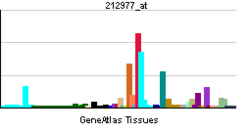CXCR7
C-X-C chemokine receptor type 7 (CXCR-7) is a protein that in humans is encoded by the CXCR7 gene.[1][2]
This gene encodes a member of the G protein-coupled receptor family. This protein was earlier thought to be a receptor for vasoactive intestinal peptide (VIP) and was considered to be an orphan receptor. It is now classified as a chemokine receptor able to bind the chemokines CXCL12/SDF-1 and CXCL11. The protein is also a coreceptor for human immunodeficiency viruses (HIV). Translocations involving this gene and HMGA2 on chromosome 12 have been observed in lipomas. Alternatively spliced transcript variants encoding the same protein isoform have been found for this gene. Whereas some reports claim that the receptor induces signaling following ligand binding, recent findings in zebrafish suggest that CXCR7 functions primarily by sequestering the chemokine CXCL12.[2]
However, another recent study has provided evidence that ligand binding to CXCR7 activates MAP kinases through Beta-arrestins, and thus has functions beyond ligand sequestration.[3]
References
- ↑ Balabanian K, Lagane B, Infantino S, Chow KY, Harriague J, Moepps B, Arenzana-Seisdedos F, Thelen M, Bachelerie F (Oct 2005). "The chemokine SDF-1/CXCL12 binds to and signals through the orphan receptor RDC1 in T lymphocytes". J Biol Chem 280 (42): 35760–6. doi:10.1074/jbc.M508234200. PMID 16107333.
- ↑ 2.0 2.1 "Entrez Gene: CXCR7 chemokine (C-X-C motif) receptor 7".
- ↑
- Rajagopal, Sudarshan. et al. (2009). "B-arrestin-but not G protein-mediated signaling by the "decoy" receptor CXCR7.". PNAS 107 (2): 628–632. doi:10.1073/pnas.0912852107. PMC 2818968. PMID 20018651.
Further reading
- Nagata S, Ishihara T, Robberecht P et al. (1992). "RDC1 may not be VIP receptor.". Trends Pharmacol. Sci. 13 (3): 102–3. doi:10.1016/0165-6147(92)90037-7. PMID 1315461.
- Libert F, Passage E, Parmentier M et al. (1992). "Chromosomal mapping of A1 and A2 adenosine receptors, VIP receptor, and a new subtype of serotonin receptor.". Genomics 11 (1): 225–7. doi:10.1016/0888-7543(91)90125-X. PMID 1662665.
- Sreedharan SP, Robichon A, Peterson KE, Goetzl EJ (1991). "Cloning and expression of the human vasoactive intestinal peptide receptor.". Proc. Natl. Acad. Sci. U.S.A. 88 (11): 4986–90. doi:10.1073/pnas.88.11.4986. PMC 51792. PMID 1675791.
- Law NM, Rosenzweig SA (1994). "Characterization of the G-protein linked orphan receptor GPRN1/RDC1.". Biochem. Biophys. Res. Commun. 201 (1): 458–65. doi:10.1006/bbrc.1994.1723. PMID 8198609.
- Shimizu N, Soda Y, Kanbe K et al. (2000). "A putative G protein-coupled receptor, RDC1, is a novel coreceptor for human and simian immunodeficiency viruses.". J. Virol. 74 (2): 619–26. doi:10.1128/JVI.74.2.619-626.2000. PMC 111581. PMID 10623723.
- Broberg K, Zhang M, Strömbeck B et al. (2003). "Fusion of RDC1 with HMGA2 in lipomas as the result of chromosome aberrations involving 2q35-37 and 12q13-15.". Int. J. Oncol. 21 (2): 321–6. doi:10.3892/ijo.21.2.321. PMID 12118328.
- Strausberg RL, Feingold EA, Grouse LH et al. (2003). "Generation and initial analysis of more than 15,000 full-length human and mouse cDNA sequences.". Proc. Natl. Acad. Sci. U.S.A. 99 (26): 16899–903. doi:10.1073/pnas.242603899. PMC 139241. PMID 12477932.
- Gerhard DS, Wagner L, Feingold EA et al. (2004). "The status, quality, and expansion of the NIH full-length cDNA project: the Mammalian Gene Collection (MGC).". Genome Res. 14 (10B): 2121–7. doi:10.1101/gr.2596504. PMC 528928. PMID 15489334.
- Hillier LW, Graves TA, Fulton RS et al. (2005). "Generation and annotation of the DNA sequences of human chromosomes 2 and 4.". Nature 434 (7034): 724–31. doi:10.1038/nature03466. PMID 15815621.
- Infantino S, Moepps B, Thelen M (2006). "Expression and regulation of the orphan receptor RDC1 and its putative ligand in human dendritic and B cells.". J. Immunol. 176 (4): 2197–207. doi:10.4049/jimmunol.176.4.2197. PMID 16455976.
- Burns JM, Summers BC, Wang Y et al. (2006). "A novel chemokine receptor for SDF-1 and I-TAC involved in cell survival, cell adhesion, and tumor development.". J. Exp. Med. 203 (9): 2201–13. doi:10.1084/jem.20052144. PMC 2118398. PMID 16940167.
- Proost P, Mortier A, Loos T et al. (2007). "Proteolytic processing of CXCL11 by CD13/aminopeptidase N impairs CXCR3 and CXCR7 binding and signaling and reduces lymphocyte and endothelial cell migration.". Blood 110 (1): 37–44. doi:10.1182/blood-2006-10-049072. PMID 17363734.
- Miao Z, Luker KE et al. (2007). "CXCR7 (RDC1) promotes breast and lung tumor growth in vivo and is expressed on tumor-associated vasculature.". PNAS 104 (40): 15735–15740. doi:10.1073/pnas.0610444104. PMC 1994579. PMID 17898181.
- Wang J, Shiozawa Y, Wang J et al. (2008). "The role of CXCR7/RDC1 as a chemokine receptor for CXCL12/SDF-1 in prostate cancer.". J Biol Chem 283 (7): 4283–4294. doi:10.1074/jbc.M707465200. PMID 18057003.
- Boldajipour B, Mahabaleshwar H, Kardash E et al. (2008). "Control of Chemokine-Guided Cell Migration by Ligand Sequestration.". Cell 132 (3): 463–473. doi:10.1016/j.cell.2007.12.034. PMID 18267076.
This article incorporates text from the United States National Library of Medicine, which is in the public domain.
| ||||||||||||||||||||||||||||||||||||||||||||||||||||||||||||||||||||||||||||||||
